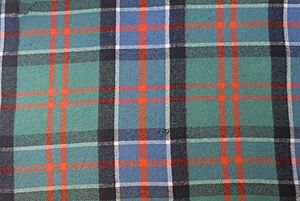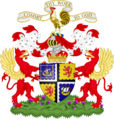Clan Sinclair facts for kids
Quick facts for kids Clan Sinclair |
|||
|---|---|---|---|
| Clann na Ceàrda or Clan na Ceàrdaich | |||
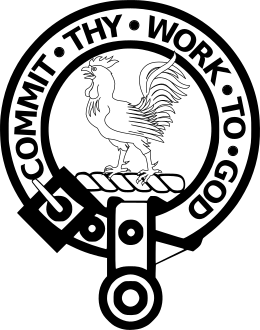
Crest: A cock rampant
|
|||
| Motto | Commit thy work to God | ||
| Profile | |||
| Region | Highlands | ||
| District | Caithness | ||
| Plant badge | Whin | ||
| Pipe music | "The Sinclair's March" | ||
| Chief | |||
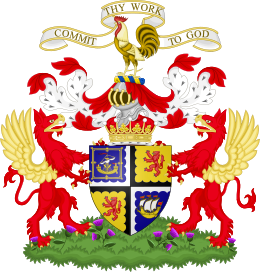 |
|||
| The Rt. Hon. Malcolm Ian Sinclair | |||
| The 20th Earl of Caithness | |||
| Historic seat | Castle Sinclair Girnigoe | ||
|
|||
|
|||
|
|||
|
|||
The Clan Sinclair (also known as Clann na Ceàrda in Gaelic) is an old and important Scottish clan. They are from the Highlands and have held lands in Caithness, the Orkney Islands, and the Lothians. The leaders of the clan were first known as the Barons of Roslin. Later, they became the Earls of Orkney and the Earls of Caithness.
The Sinclair family is thought to have come from Normandy, a region in France. They arrived in England during the Norman conquest of England in the 11th century. After that, they moved to Scotland. The Sinclairs were loyal to the Scottish kings. They fought for Scotland during the Scottish–Norwegian War and the Wars of Scottish Independence.
A famous member, William Sinclair, 1st Earl of Caithness, founded the beautiful Rosslyn Chapel in the 15th century. He decided to divide the family lands differently. His oldest son from his first marriage, William ("the Waster"), became Lord Sinclair. But the lands of Caithness went to his second son from his second marriage, William Sinclair, 2nd Earl of Caithness, in 1476. The lands at Roslin went to his oldest son from his second marriage, Sir Oliver Sinclair.
In the 16th century, the Sinclairs fought against England in the Anglo-Scottish Wars. They also had conflicts with their neighbors, the Clan Sutherland. During the Jacobite rising of 1715, many Sinclairs supported the Jacobite cause. However, by the Jacobite rising of 1745, the clan's chief, the Earl of Caithness, supported the British government.
Today, the chief of Clan Sinclair is Malcolm Sinclair, 20th Earl of Caithness.
Contents
- Where Did the Sinclairs Come From?
- Fighting for Scotland: Early Battles
- Important Sinclairs in the 14th Century
- The 15th Century: New Titles and a Famous Chapel
- The 16th Century: Battles and Feuds
- The 17th Century and Civil War
- The 18th Century and Jacobite Risings
- Clan Castles
- Clan Profile
- Images for kids
Where Did the Sinclairs Come From?
It's believed the Sinclair family came from a place called Saint-Clair in Normandy, France. The first Saint-Clairs came to England with William the Conqueror in 1066. Their name, "Saint-Clair," was originally a place name.
One of the first Sinclairs recorded in Scotland was Henry of Saint-Clair/Sinclair. He was given land in Haddingtonshire in 1160. The main leaders of Clan Sinclair, the Earls of Caithness, are descended from William St. Clair. He was a sheriff in Edinburgh and was granted the lands of Roslin (Rosslyn) in 1280.
Fighting for Scotland: Early Battles
Scottish-Norwegian War (1263)
During the Scottish–Norwegian War, Haakon IV of Norway invaded Scotland. At the Battle of Largs in 1263, William St. Clair led a part of Alexander III of Scotland's army against the Norwegians. The Scots won this battle.
Wars of Scottish Independence (1296-1314)
During the Wars of Scottish Independence, Sir William Sinclair of Rosslyn was captured at the Battle of Dunbar (1296). He later died, likely in the Tower of London. His son, Henry, was also captured.
In 1303, the Battle of Roslin took place. Scots, led by Henry Sinclair of Rosslyn and the Clan Comyn, defeated an English force. The Sinclairs later supported Robert the Bruce. They fought with him at the Battle of Loudoun Hill in 1307, where the Scots again defeated the English.
The Battle of Bannockburn was fought in 1314. Clan Sinclair bravely fought to support Robert the Bruce. After this important victory, Robert the Bruce gave William Sinclair his sword as a sign of respect.
Carrying Robert the Bruce's Heart
Sir William Sinclair, Henry's son, and his brother John, were among the Scots who died with Sir James Douglas at the Battle of Teba in 1330. They were on a journey to carry Robert the Bruce's heart to the Holy Land. Their bones are said to be buried in Rosslyn Chapel.
Important Sinclairs in the 14th Century
In 1379, Sir Henry Sinclair, who was also the Admiral of Scotland, became the Earl of Orkney. He received this title from Haakon VI of Norway.
Henry I Sinclair was a Scottish explorer and nobleman. In 1391, he took control of the Faroe Islands. Some people believe he might have traveled as far as the Americas in 1398, possibly landing in Massachusetts and Nova Scotia. However, this journey to America is still debated by historians. He died in battle around the year 1400.
The 15th Century: New Titles and a Famous Chapel
Henry II Sinclair, Earl of Orkney was captured by the English in 1402 but was soon set free. In 1406, he was escorting Prince James to France when their ship was captured by the English. Both were held in the Tower of London. Henry later escaped or was released in 1407.
William Sinclair, 1st Earl of Caithness (who was also the 3rd Earl of Orkney and Baron of Roslin) was a very important person. He served as the High Chancellor of Scotland from 1454 to 1458. He was given the title of Earl of Caithness in 1455. This William Sinclair was the one who founded the famous Rosslyn Chapel.
He decided to divide his family's lands. He gave the lands of Caithness to his second son from his second marriage, William Sinclair, 2nd Earl of Caithness, in 1476. The lands at Roslin went to his oldest son from his second marriage, Sir Oliver Sinclair. His eldest son from his first marriage, William ("the Waster"), inherited the title of Lord Sinclair.
The 16th Century: Battles and Feuds
William Sinclair, 2nd Earl of Caithness was killed fighting for James IV of Scotland at the Battle of Flodden in 1513. About 300 Sinclairs died in this battle, including other important family members.
John Sinclair, 3rd Earl of Caithness died at the Battle of Summerdale in Orkney in 1529. His son, George Sinclair, 4th Earl of Caithness, took his place. At the Battle of Solway Moss in 1552, Scots led by Oliver Sinclair of Pitcairns were defeated by the English.
In 1568, Henry Sinclair, 6th Lord Sinclair helped Mary, Queen of Scots, escape from Loch Leven Castle. In 1570, John Sinclair, Master of Caithness, burned a local Cathedral while chasing the Morays. Later, his father, George Sinclair, 4th Earl of Caithness, put him in prison for making peace with the Morays.
In 1588, Castle Sinclair Girnigoe was attacked but held strong against the Earl of Sutherland. In 1590, George Sinclair, 5th Earl of Caithness invaded Sutherland, leading to the Battle of Clynetradwell.
The 17th Century and Civil War

In 1606, George, 5th Earl of Caithness, was allowed to change the name of Girnigoe Castle to Sinclair Castle.
In 1612, George Sinclair and most of his men were killed in an ambush in Norway at the Battle of Kringen.
During the English Civil War, in 1650, Major Sinclair helped James Graham, 1st Marquess of Montrose at the Battle of Carbisdale. They were defeated and later captured and executed. Sir William Sinclair of Rosslyn was killed at the Battle of Dunbar (1650). He was the last knight to be buried in full armor below Rosslyn Chapel.
In 1680, a conflict happened between George Sinclair of Keiss and Sir John Campbell of Glenorchy. They were fighting over who had the right to the lands and title of the Earldom of Caithness. This led to the Battle of Altimarlach. Legend says so many Sinclairs were killed that the Campbells could cross the river without getting their feet wet. However, the Sinclairs managed to get the earldom back a few years later in 1681 by order of Parliament.
The 18th Century and Jacobite Risings
During the Jacobite rising of 1715, many Sinclairs supported the Jacobite cause, which wanted to bring the Stuart kings back to the throne. However, by the time of the Jacobite rising of 1745, the Clan Sinclair supported the British Hanoverian Government.
In 1708, John, Master of Sinclair, was sent away to Prussia after killing two men in duels. He was later pardoned. In 1715, he captured a ship carrying weapons meant for the Earl of Sutherland. At the Battle of Sheriffmuir in 1715, David Sinclair of Brabsterdorran fought for the Jacobites.
In 1736, Sir James Sinclair fixed up Rosslyn Chapel. He put in glass windows, relaid the floor, and repaired the roof. The Sinclairs of Roslin (Rosslyn) claimed to be the hereditary Grand Master Masons of Scotland. In 1739, William St Clair became the first elected Grand Master of the Grand Lodge of Scotland.
On April 16, 1746, at the Battle of Culloden, Sir James Sinclair of Rosslyn commanded the Royal Scots regiment for the British-Hanoverian Government. Although the clan generally had Jacobite sympathies, their chief, the Earl of Caithness, supported the government.
Clan Castles
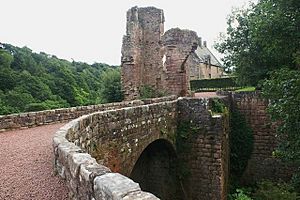
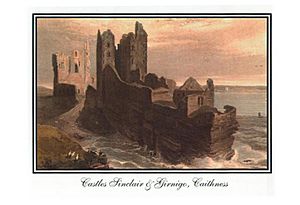
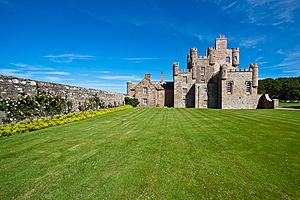

The Sinclairs have owned or built many castles. Here are some of the most important ones:
- Roslin Castle, also known as Rosslyn Castle, is in Midlothian. It was the earliest home of the Sinclairs in Scotland. The ruins show it was once a very large and strong castle. The main tower is now ruined, but a part built in the 16th century is still mostly complete. The castle was attacked and burned in 1544 and again in 1650. It was also damaged by a mob in 1688. The castle is now owned by the Sinclair-Erskine family. The Sinclairs also built the famous Rosslyn Chapel nearby.
- Castle Sinclair Girnigoe, near Wick, Caithness, was once thought to be two castles, but it was likely one large fortress. Not much is left of the part called Castle Sinclair, but the Castle Girnigoe part is a big ruin that stands five stories high on a cliff by the sea. The castle was damaged by the Clan Campbell after the Battle of Altimarlech in 1681. Today, the Clan Sinclair Trust takes care of the castle.
- Castle of Mey, about 7 miles (11 km) northeast of Castletown, Caithness, is a Z-plan tower house. It is six stories tall and was built in the 16th century. The Sinclair Earls of Caithness owned it from 1566. In 1952, Queen Elizabeth The Queen Mother bought the castle and had it restored.
- Ravenscraig Castle, near Kirkcaldy, was built in the 15th century. It was one of the first castles in Britain designed for both defending against and using artillery. The Sinclairs received Ravenscraig after they gave up the Earldom of Orkney. They owned it until 1650 and finished building it. The castle is now cared for by Historic Scotland and is open to the public.
- Ackergill Tower, near Wick, Caithness, was taken by the Sinclairs in 1547 but later returned to the Clan Keith. The Sinclairs got it back in 1612.
- Braal Castle, near Thurso, Caithness, is a ruined castle that passed to the Sinclair Earls of Caithness by 1547.
- Dunbeath Castle, near Dunbeath, Caithness, was acquired by the Sinclairs in the 15th century.
- Keiss Castle, near Wick, Caithness, was the original castle of the Sinclairs of Keiss. They left it for a new Keiss Castle in 1755. The old castle is now very ruined.
- Castle of Old Wick, near Wick, Caithness. During a feud between the Clan Sutherland and Clan Sinclair, the castle was forced to surrender in 1595. It is now cared for by Historic Scotland.
- Thurso Castle, near Thurso, Caithness, is a ruined mansion on the site of an old castle. It was home to Sir John Sinclair, 1st Baronet of Ulbster. He wrote the Statistical Account of Scotland and died in 1835. This line of Sinclairs still lives in Caithness today.
Clan Profile
- Clan Chief: Malcolm Ian Sinclair, 20th Earl of Caithness
- Chief's Motto: "Commit thy work to God"
- Chief's Crest: A rooster standing on one leg (a cock rampant)
- Clan Plant Badge: Whin (a spiky yellow-flowered plant)
- Lands: Midlothian, Orkney and Caithness
- Gaelic Name: Mac na Ceardadh
- Origin of Name: From a place name in French: "de Sancto Claro"
- Pipe Music: "Spaidsearachd Mhic nan Cearda" ("The Sinclair's March")
Images for kids




